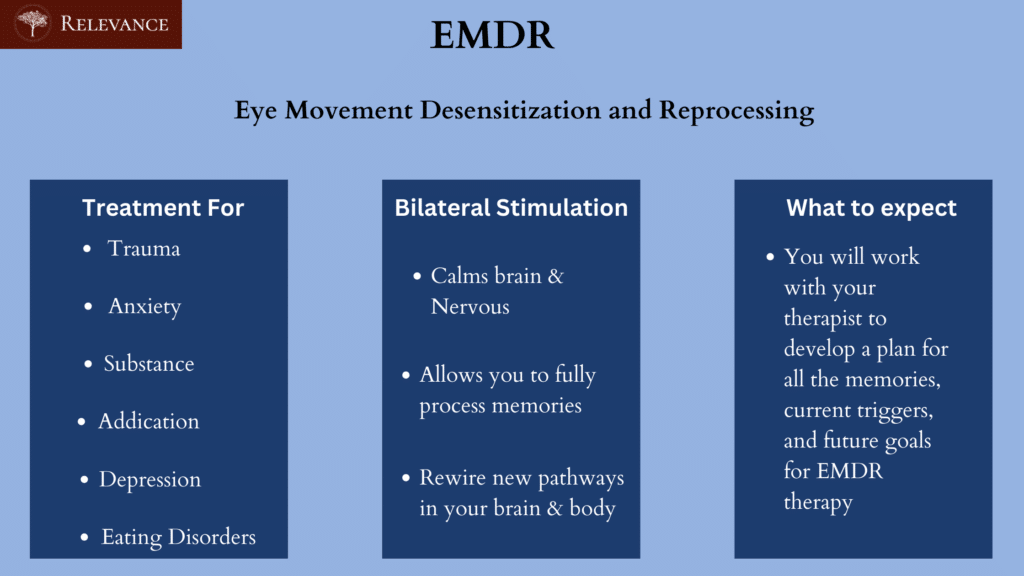If you are unsure about how anxiety treatments are done, EMDR for anxiety is one of the proven methods to lower anxiety levels, and understanding the process behind this is important.
It should come as no surprise that anxiety is becoming a more common problem for many people in a world where things frequently move at an overwhelming speed. The relentless demands of contemporary life can hurt our mental health, leading a great number of people to look for efficient relief.
Of the various therapeutic modalities, Eye Movement Desensitization and Reprocessing (EMDR) therapy has drawn significant notice due to its efficaciousness in treating anxiety. According to the EMDR Research Foundation, EMDR has been professionally validated by more than 30 control studies EMDR was first created to treat trauma, but it has since developed into a flexible tool in the field of mental health, giving hope to people looking for a way to experience significant anxiety relief.
What is EMDR treatment?
Francine Shapiro created the psychotherapy technique of Eye Movement Desensitization and Reprocessing (EMDR) in the late 1980s. Originally intended to ease the pain brought on by painful memories, it has subsequently been modified for use in the treatment of several mental health conditions, such as anxiety, phobias, and post-traumatic stress disorder (PTSD).

1. Eight-Phase Approach:
The standard protocol for EMDR therapy consists of eight phases, each of which has a distinct function in the therapeutic process. Among these stages are:
- History-Taking and Treatment Planning: The therapist determines the target areas for treatment after learning about the client’s past.
Setting up a therapeutic alliance, outlining the EMDR procedure, and making sure the client has the coping mechanisms required to control their emotional discomfort are all part of the preparation. - Assessment: Determining which particular target memories or experiences are upsetting.
- Desensitization: The central stage in which the client concentrates on upsetting memories while receiving bilateral stimulation, usually in the form of directed eye movements. This procedure facilitates a less emotionally charged processing of the memories.
- Installation: To replace the negative beliefs connected to the targeted memories, and promote positive self-esteem and beliefs.
2. Bilateral Stimulation:
Guided eye movements, auditory tones, or tactile stimulation can all be used to accomplish bilateral stimulation, which is a fundamental component of EMDR. It is thought that by stimulating the brain back and forth, traumatic memories can be reprocessed and become less emotionally charged.
3. Modifications for Anxiety and Other Problems:
Although EMDR was first created to treat trauma, therapists have discovered that it is useful for treating a wider variety of mental health problems. When applied to anxiety, EMDR assists people in analyzing and reframing the memories and ideas that are causing them to feel anxious.
4. Client-Centered and Individualized:
EMDR therapy is client-centered, which means that each patient’s needs are taken into account when designing a treatment plan. The client and the therapist collaborate to address the memories or experiences that are causing the client’s distress.
How EMDR works?
Eye Movement Desensitization and Reprocessing, or EMDR, is a treatment that assists people in processing upsetting memories and experiences that underlie emotional disorders like PTSD, anxiety, and phobias. The International Society for Traumatic Stress Studies and the American Psychiatric Association both support EMDR therapy.
A systematic eight-phase approach is used in the therapy, with a focus on bilateral stimulation in particular, as this is thought to help the brain reprocess and desensitize traumatic memories. This is an explanation of how EMDR functions:
1. Taking History and Planning Treatment:
The therapist learns about the client’s past and pinpoints particular memories or experiences that are upsetting. The client and the therapist work together to develop the objectives and goals of the treatment.
2. Preparation:
The therapist makes sure the client has coping mechanisms to deal with emotional distress and goes over the EMDR procedure with them. Establishing a therapeutic relationship promotes safety and trust.
3. Assessment:
Memories or experiences that are the target are determined. Usually, the client’s emotional problems are a result of these memories. The client assigns a number to each target’s level of distress.
4. Desensitization:
The patient engages in bilateral stimulation while concentrating on a particular target memory. This may entail paying attention to the therapist’s moving finger, sounds, or tactile cues. Bilateral stimulation is believed to help the memory be reprocessed and become less emotionally charged.
5. Installation:
The previously upsetting recollection is linked to positive beliefs.
Positive beliefs are intended to take the place of negative ones to encourage a more healthy emotional and cognitive response.
6. Body Scan:
Any lingering physical strain or pain linked to the memory that is being targeted is found and dealt with. The therapist makes sure that all physiological and emotional processing of the memory is completed.
7. Closure:
The session comes to an end when it is decided the client is in a stable emotional state.
Up until the following session, the client is encouraged to practice self-care and receive reinforcement for their coping mechanisms.
8. Reevaluation:
In later sessions, the status is checked and any outstanding problems are addressed.
Two ways to achieve bilateral stimulation are guided eye movements, auditory tones, or tactile stimulation (tapping, for example). It is thought that back-and-forth stimulation helps the brain integrate and reprocess memories by simulating the natural processing that takes place during Rapid Eye Movement (REM) sleep.
9. Mechanisms of Action:
Theories indicate that bilateral stimulation may improve communication between the brain’s hemispheres, enabling the reprocessing of traumatic memories from a more adaptive perspective, even though the precise mechanisms underlying EMDR are not entirely understood.
10. Neurobiological Changes:
According to some research, EMDR may cause changes in the brain’s neurophysiology, including how memories are accessed and stored.
It’s critical to remember that EMDR is an organized, empirically supported therapy whose efficacy has been shown in studies.
How does EMDR work for anxiety?
Through processing and reframing upsetting memories and experiences that fuel anxious thoughts and feelings, EMDR (Eye Movement Desensitization and Reprocessing) therapy can help treat anxiety. The way EMDR specifically addresses anxiety is as follows:
1. Identifying Target Memories:
The therapist collaborates with the patient to pinpoint particular memories or experiences that fuel their anxiety during the early stages of EMDR.
These could be self-defeating beliefs, upsetting experiences, or traumas from the past.
2. Recognizing Adverse Beliefs:
The therapist assists the patient in investigating and comprehending the unfavorable ideas connected to the recognized memories.
These unfavorable ideas, which can include “I am not safe” or “I am not in control,” frequently fuel anxiety.
3. Diminished Sensitivity:
In the desensitization stage of EMDR, the patient engages in bilateral stimulation while maintaining attention to the recognized target memory.
Guided eye movements, auditory tones, or tactile sensations can all be used as forms of stimulation. Bilateral stimulation is believed to help the person access and reprocess the upsetting content in a less emotionally charged manner by facilitating memory processing.
4. Rethinking Adverse Thoughts:
The therapist assists the patient in reprocessing the unfavorable beliefs connected to the target memory as desensitization takes place.
Good ideas are presented and connected to the upsetting recollection. If the negative belief is “I am not safe,” the positive belief could be “I am safe right now.”
5. Positive Belief Installation:
The intention is to swap out the negative beliefs for more adaptable and positive ones. The installation process aids in the development of a more positive emotional and cognitive response to the formerly upsetting memory.
6. Handling Physical Sensations:
EMDR also entails a body scan phase in which any lingering physical strain or pain related to the memory under study is found and treated. This helps the memory to be processed more thoroughly.
7. Integration and Closure:
The therapist assists the patient in incorporating the newly formed positive beliefs into their overall self-concept and makes sure that the processing is finished. The way the session is concluded encourages stability and closure.
8. Tracking Progress:
In later sessions, the status is checked, any unresolved problems are dealt with, and if necessary, new target memories are identified.
Benefits of EMDR for anxiety
1. Taking Care of the Fundamentals:
Through the treatment of particular memories or experiences that exacerbate anxious thoughts and feelings, EMDR aims to address the underlying causes of anxiety.
2. Restructuring cognition:
A change in general cognitive patterns results from the therapy’s assistance in helping patients reframe harmful beliefs and swap them out for more adaptive and positive ideas.
3. Cutting Down on Emotional Reactivity:
EMDR helps people become less emotionally reactive to triggers that may have previously caused anxiety by desensitization and reprocessing upsetting memories.
4. Comprehensive Method:
By treating the cognitive as well as the physiological components of anxiety, EMDR adopts a comprehensive strategy that encourages a more thorough and long-lasting recovery.
The Theories Of EMDR for Anxiety
Numerous theories and studies have backed up the effectiveness of EMDR (Eye Movement Desensitization and Reprocessing) therapy. While the specific mechanisms behind the effectiveness of EMDR remain to be conclusively established, several theories offer insights into the reasons behind and potential mechanisms of action of this therapeutic approach:
1. Model of adaptive information processing (AIP):
An important theory is the Adaptive Information Processing (AIP) model, which was developed by Francine Shapiro, the person who created EMDR. According to this theory, traumatic events, in particular, can overwhelm the brain’s natural processing mechanisms, causing unfavorable thoughts, feelings, and physical sensations to linger.
By simulating the processing that naturally takes place during Rapid Eye Movement (REM) sleep through bilateral stimulation, such as eye movements, EMDR is thought to support the brain’s adaptive processing. This facilitates the integration and reprocessing of the upsetting memories, enabling the person to come to a more flexible conclusion.
2. Memory Reconsolidation Theory:
When explaining EMDR, memory reconsolidation is occasionally brought up. This theory states that a memory is temporarily labile and modifiable upon retrieval before it is permanently stored.
It is believed that the bilateral stimulation used in EMDR disrupts the neural networks that are currently linked to upsetting memories, enabling the reconsolidation of the memory with fresh, more useful information.
3. Dual Attention Hypothesis:
According to this theory, processing traumatic memories is aided by the dual attention that EMDR provides, in which the patient attends to both the upsetting memory and bilateral external stimulation.
Dual attention strains working memory, preventing cognitive avoidance and enabling a more direct interaction with the traumatic content.
4. Neurobiological Alterations:
EMDR may cause the brain to undergo neurobiological alterations. According to certain research, there may be changes in brain activity and connectivity, especially in areas linked to memory processing and emotional control. These modifications could be part of what makes EMDR therapy work as it does.
5. Bilateral Stimulation and Hemispheric Integration:
It is believed that the bilateral stimulation utilized in EMDR facilitates hemispheric communication. It is thought that this integration aids in the reprocessing of traumatic memories, resulting in a more flexible interpretation of the event.
6. Reduction of Emotional Reactivity:
By changing the emotional charge connected to upsetting memories, EMDR is thought to lessen emotional reactivity. The goal of therapy is to change the emotional impact of traumatic memories so that people can remember or think about them with less distress.
7. Cognitive Restructuring:
Using EMDR, negative beliefs connected to traumatic memories are questioned and changed to facilitate cognitive restructuring. People gain a more adaptive perspective on themselves and their experiences as a result of the positive beliefs that are introduced to them during therapy.
The usefulness of EMDR is well-supported by clinical evidence, even though these theories offer frameworks for comprehending the possible mechanisms of action. Studies on a variety of mental health issues, such as PTSD, anxiety, and depression, have shown promising results.
FAQs
1. How many sessions will I need for EMDR for anxiety treatment?
Although treatment can proceed quickly, the number of sessions required will depend on how complex the problems are. Following an EMDR session, there could be a profound sense of healing, openness, and relief. Because it requires fewer sessions than traditional therapy, EMDR therapy is more affordable. In the first few sessions, emotional distress is frequently relieved.
2. What type of issues does EMDR is best suitable for?
PTSD, anxiety, panic attacks, fear and phobias, stress, grief and loss, and more can all benefit from EMDR therapy. problems in relationships, trauma experienced as a child, Sexual abuse, physical abuse, stress at work, Reduced tension, Natural disasters, violent crimes, and auto accidents trauma in schools, Fear of spiders, Controlling one’s anger, social phobia, Chronic or physical illness, nightmares, flashbacks, birth trauma, recuperation from divorce, Reduced self-worth, procrastination, perfectionism, addictions, compulsions/OCD, artistic blockages, athletic performance, goal-setting, and life transitions.
3. What is the overall appearance of the EMDR treatment?
The past, present, and future are the three main areas of focus for EMDR. The reason the past is prioritized is because the unresolved pain from the past—whether from childhood or more recent experiences—is what is causing suffering in the present. Hence, addressing the past will get to the heart of the issue. For instance, since the death in the family is the source of the client’s depression, we would first address the period immediately following the death if the client presents with depression and has a history of depression stemming from it.
Relying solely on treating the current symptoms of depression would be analogous to treating a brain tumor-related headache with aspirin instead of treating the tumor itself.
Most of the symptoms that are present now will go away once the previous pain is gone. Whatever remains unsettled in the here and now is dealt with next.
Next is getting ready for the future. Many people are afraid of the effects of healing—how it will alter their lives, how they will behave now that they have a different outlook on the world, etc. To work in the “future,” one must be ready.
4. Does EMDR work with a computer? How does one go about doing this?
EMDR can be performed virtually, yes. I have discovered several ways to make the technique work in virtual environments, despite your doubts. A crucial component of EMDR is bilateral stimulation, which involves stimulating the brain’s left and right hemispheres. I give my clients two options for their auditory bilateral stimulation: they can download a free app that plays alternating clicking sounds through headphones, or they can practice self-tapping, which involves tapping alternately on each arm and leg.
Another way to use eye movements is to have the patient place two objects outside of the computer’s field of view, and then alternate between the two objects while the therapist watches the patient’s eye movements. The procedure functions as though we were in the same room, even though that is not possible.
5. How will I know if EMDR is right for my anxiety treatment?
- Speak with a certified Mental Health Professional: Make an appointment to speak with a psychologist or therapist, among other certified mental health professionals. They will evaluate your symptoms, background, and particular concerns.
- Talk About Your Objectives: Talk to the therapist about your issues and treatment goals. To customize the technique, it is helpful to communicate your individual needs. EMDR is useful for a variety of conditions, including trauma and anxiety.
- Assessment & Evaluation: To ascertain whether EMDR is a good fit for your situation, the therapist will carry out an assessment. They take into account things like your past mental health history, your present symptoms, and the type of traumatic events you’ve had.
- Be Honest: Be upfront about how comfortable you are with the therapeutic process. Making an educated decision might be aided by discussing any possible concerns and learning how EMDR operates.
- Examine Your Options: Your therapist may talk to you about alternate treatment modalities and their possible advantages. You and your partner can determine whether EMDR suits your preferences and objectives.
- Considering Trauma: EMDR may be especially helpful if you have had traumatic experiences. The therapist will, however, determine whether you are emotionally ready for the process and whether you need further support.
Conclusion
In summary, exploring the field of Eye Movement Desensitization and Reprocessing (EMDR) treatment offers a bright future for those who are looking to alleviate their anxiety. Beyond conventional treatment approaches, the many benefits of EMDR offer a distinct and efficient way to address the complex web of anxiety-related issues.
One of the most notable benefits of EMDR for anxiety is resolving underlying traumatic events. Through methodical reprocessing of upsetting memories, people can discover a route to resilience and emotional recovery. With the help of this therapy method, people can not only learn to manage their anxiety symptoms but also completely change the way they relate to their past traumas, which lessens the negative effects they have on their current well-being.
Another aspect of EMDR that makes it a useful weapon in the fight against anxiety is its adaptable nature. It is a flexible option for people with a range of anxiety disorders because its application goes beyond the domain of overt trauma. When dealing with phobias, panic attacks, or generalized anxiety, EMDR provides a customized strategy that adjusts to the particular requirements of every person, encouraging a sense of agency in the recovery process.
Along with EMDR, Relevance Recovery has other methods to treat various mental issues based on the level of treatment required. They offer holistic, integrative, multidisciplinary treatment for substance abuse & mental illness.
EMDR therapy is essentially a ray of hope for people navigating the treacherous landscape of anxiety. Its evidence-based efficacy, adaptability, accessibility, and comprehensive methodology come together to provide a route that leads to significant personal transformation as opposed to merely symptom relief.









